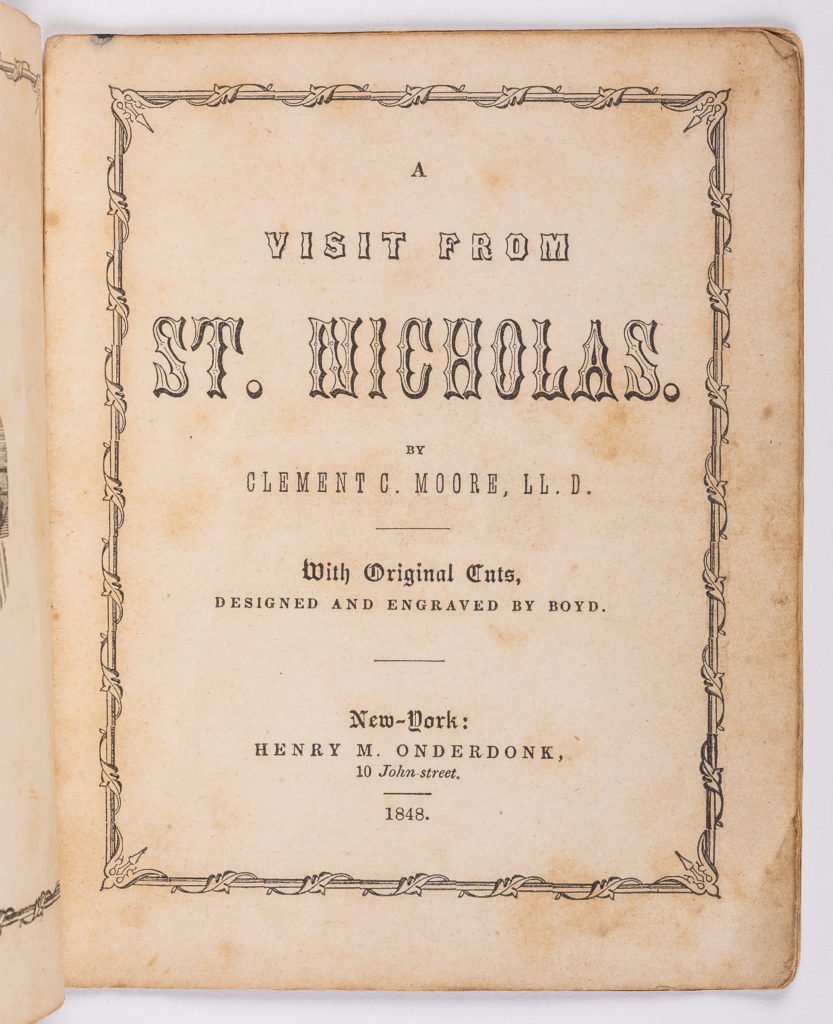The Connection Between "A Visit from St. Nicholas" and Mississauga
/A Visit from St Nicholas 1848
A Visit from St. Nicholas (also known as ‘Twas the Night Before Christmas) was first published anonymously on December 23, 1823 in New York’s Troy Sentinel newspaper under the title Account of a Visit from St. Nicholas. The newspaper republished it in 1829, but it was not until 1837 that the poem was formally attributed to Clement Clarke Moore (1779-1863). In 1842 William Cullen Bryant credited Moore as the author when the poem was included in his compilation of American poetry. Moore himself claimed authorship in 1844 when the poem was included in his published collection Poems. In Moore’s explanation of the poem, he indicated that he had written it in 1822 for the amusement of his own children, never intending to publish it. Moore acknowledged that his narrative depiction of St. Nicholas leaned heavily on the work of his friend, Washington Irving, and the poem was written at a time of emerging and evolving Christmas-time concepts and traditions. The poem has been called “arguably the best-known poem ever written.” (There are some who attribute the poem to Henry Livingston, rather than Moore.)
Clement C Moore
Looking back on Moore’s own narrative, the poem was originally intended to amuse his own children. In 1822 Moore and his family were living in Chelsea, Manhattan, New York. The Moore household included his wife, Catherine Elizabeth Taylor (1783-1830), and six young children: Margaret, Charity, Benjamin, Mary, Clement Jr. and Emily. In the years that followed the poem’s initial publication in 1823, three more children would be welcomed into the Moore home: William, Catherine and Maria. One can imagine Clement reading the poem to his delighted children as ideas of St. Nicholas (Santa Claus) were starting to shape concepts around Christmas in New York and beyond.
Published on the eve of the Victorian era, the poem, along with many other early traditions, gained tremendous popularity. In 1848 the poem was published with wood engravings by Theodore Boyd, giving images to Moore’s word. Another illustrated version was published by L. Prang & Co. in Boston in 1864.
A Visit from St Nicholas - illustrated, 1864
Although it is not known when the poem first came to Canada, there is reference to it in 1850. It likely came to the attention of early residents much earlier than that, possibly by the 1830s as the poem appeared in the widely available publication: The New-York Book of Poetry, edited by Charles Fenno Hoffman. Although we do not know precisely when the poem arrived in Canada, it certainly did achieve tremendous popularity and was widely republished.
So, what does this have to do with Mississauga? It is a bit of leap here, so stay with me …
As we have explored in previous articles, Cooksville was named after Jacob Cook (1796-1873). Jacob and his wife, Anna Ogden (1801-1846), Jacob and Anna had 12 children: Hannah (1820-1910), Anna Christina (1822-1915), Jacob Jr. (1824-1826), Mary Caroline (1826-1927), William (1828-1834), Gideon Clarke (1831-1861), Pizarius (1834-1836), Henrietta Augusta (1836-1911), Miles Washington (1838-1895), Eliza Naomi (1840-1841), Charles (1842-1843) and Eliza Mahala (1844-1846), Many of the children died young, and life for the Cook family certainly had heartbreak.
Grave marker for Mary and John Doughty Ogden, Trinity Church Cemetery, Manhattan, New York
Jacob and Anna lived at the same time as Clement C. Moore. At the time of his poem’s initial publication and rising popularity, Jacob was building his marvelous mail network. One can picture early publications carrying this poem crossing paths with Jacob in historic Cooksville. As the poem, and the early stories around Santa Claus, gained in popularity, you can imagine Jacob’s children taking that in, perhaps even being buoyed at Christmastime by storytelling, and maybe even a re-telling of Moore’s poem. Perhaps there was even a time in the late 1830s or early 1840s that Hannah, Mary, Gideon, Henrietta, Miles and their other siblings may have gathered by the hearth to listen to Jacob recount the poem, with their own childhood imaginations providing vivid images to Moore’s words. But, would they have known of their own distant connection?
Gravestone for Anna Ogden Cook, Dixie Union Cemetery, Mississauga
Clement C. Moore’s daughter, Mary Clarke Moore (1819-1893) was married to Dr. John Doughty Ogden (1804-1887) in New York. Dr. John Doughty Ogden was a distant cousin of Jacob Cook’s wife, Anna Ogden. They likely share a common ancestor in their 5x great-grandfather, John Ogden (1600-1682), who was a very early settler in New York. Anna was only 3 years older than her distant cousin. One wonders if they might have known of each other.
The Board and Staff at Heritage Mississauga wish you a very Merry Christmas, Happy Holidays, and a Happy and Healthy New Year!
















